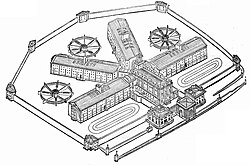Crime pattern theory is a way of explaining why people commit crimes in certain areas. Crime is not random, it is either planned or opportunistic. [citation...
9 KB (1,295 words) - 08:23, 23 February 2024
premeditation. This theory focuses on the right circumstances for a crime of opportunity to occur. The three main components of this theory emphasize an offender...
4 KB (472 words) - 11:44, 22 March 2025
to maximize efficiency. Crime pattern theory consists of four key points: (1) that criminal events are complex, (2) that crime is not random, (3) that...
12 KB (1,510 words) - 13:22, 21 September 2024
hotspots. A widely used theory to explain crime is crime pattern theory. Crime pattern theory explains that crime is not random. Crime hotspots can help aid...
27 KB (3,757 words) - 01:48, 30 January 2025
Routine activity theory is a sub-field of crime opportunity theory that focuses on situations of crimes. It was first proposed by Marcus Felson and Lawrence...
16 KB (1,993 words) - 15:38, 22 December 2024
in crime rates, including conflict theory, strain theory, general strain theory, social disorganization theory, macrostructural opportunity theory, social...
103 KB (12,562 words) - 07:15, 18 March 2025
Criminology (redirect from Theory of crime)
across cultures, to identify differences and similarities in crime patterns. Crime prevention Crime statistics Criminal behavior Criminal careers and desistance...
67 KB (8,246 words) - 04:10, 5 May 2025
Bloodstain pattern analysis (BPA) is a forensic discipline focused on analyzing bloodstains left at known, or suspected crime scenes through visual pattern recognition...
41 KB (5,170 words) - 16:36, 22 April 2025
Crime mapping is used by analysts in law enforcement agencies to map, visualize, and analyze crime incident patterns. It is a key component of crime analysis...
6 KB (696 words) - 21:27, 29 January 2024
Crime opportunity theory suggests that offenders make rational choices and thus choose targets that offer a high reward with little effort and risk. The...
13 KB (1,547 words) - 01:05, 3 February 2024
windows theory states that visible signs of crime, antisocial behavior and civil disorder create an urban environment that encourages further crime and disorder...
70 KB (8,515 words) - 22:07, 18 April 2025
After decades of increasing crime across the industrialised world, crime rates started to decline sharply in the 1990s, a trend that continued into the...
16 KB (1,861 words) - 15:24, 28 December 2024
Geographic profiling (category Crime mapping)
necessary to commit crimes. Crime pattern theory Developed by Canadian environmental criminologists Paul and Patricia Brantingham, the theory exerts the strongest...
17 KB (2,211 words) - 13:31, 13 January 2025
theory is a theoretical perspective that aims to explain the relationship between social structure, social values or goals, and crime. Strain theory was...
37 KB (4,933 words) - 10:13, 4 May 2025
Crime analysis is a law enforcement function that involves systematic analysis for identifying and analyzing patterns and trends in crime and disorder...
11 KB (1,442 words) - 22:23, 18 January 2025
construction of technology Actor-network theory Normalization process theory Theories of technology The general theory of crime refers to the proposition by Michael...
61 KB (6,100 words) - 00:32, 8 May 2025
additional factors that may influence crime patterns. Criminologists and researchers have proposed various theories to explain the potential relationship...
23 KB (2,644 words) - 15:37, 23 August 2024
figure to prevent the crime from happening. Routine activity theory relates the pattern of offending to the everyday patterns of social interaction....
18 KB (2,205 words) - 18:45, 25 October 2024
The crime drop or crime decline is a pattern observed in many countries whereby rates of many types of crime declined by 50% or more beginning in the mid...
35 KB (3,897 words) - 15:18, 1 December 2024
identified attachment patterns in infants: secure, avoidant, anxious, and disorganized attachment. In the 1980s, attachment theory was extended to adult...
196 KB (23,083 words) - 10:06, 8 May 2025
the prevalence of organized crime in society. The alien theory posits that the contemporary structures of organized crime gained prominence during the...
167 KB (19,317 words) - 05:36, 6 May 2025
Environmental criminology (category Environmental crime)
the area becomes scarcer in population, the crime will progressively become more serious. Crime pattern theory Environmental justice Environmental law Green...
9 KB (1,085 words) - 20:13, 22 April 2024
that are conducive to crime and violence. The primary focus is on juvenile delinquency because theorists believe that if this pattern of offending can be...
8 KB (1,033 words) - 19:26, 10 March 2023
trials, that seek to identify patterns of offending behaviour and factors that influence criminal offending behaviour and crime. The multi-disciplinary approach...
24 KB (2,621 words) - 10:52, 25 June 2024
suspicious patterns and later identify them. Neighborhoods can adopt various strategies to reduce violent crime. The broken windows theory, though widely...
33 KB (4,159 words) - 20:25, 1 May 2025
living in an area with a high-crime rate. Elihu Katz, the founder of uses and gratifications theory, listed cultivation theory in his article, "Six Concepts...
82 KB (10,523 words) - 15:18, 26 April 2025
this theory and its rise to popularity. Labeling theory is also connected to other fields besides crime. For instance there is the labeling theory that...
56 KB (7,269 words) - 09:27, 4 May 2025
be used to identify whether a crime is a victimless crime: if the act is excessive, is indicative of a distinct pattern of behavior, and its adverse effects...
16 KB (1,887 words) - 04:24, 11 March 2025
might fit a specific pattern. Victimology has a broad range of different theories; the most prevalent one is abuse. Various theories of victimology exist...
3 KB (425 words) - 07:37, 19 February 2024
investigators may invoke routine activity theory and rational choice theory in relation to the location of crimes. Crime patterns have to be carefully considered...
7 KB (750 words) - 02:11, 23 January 2025










